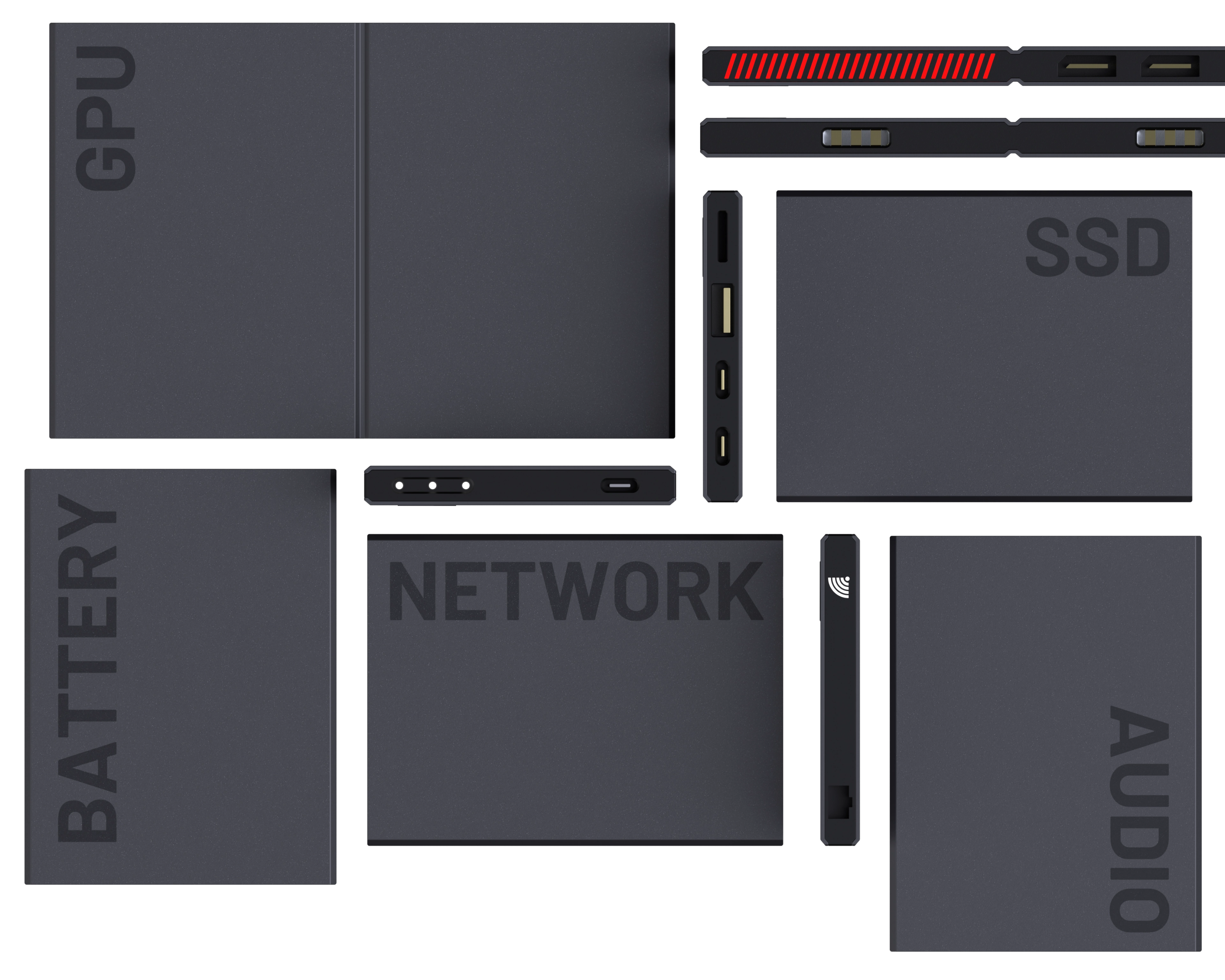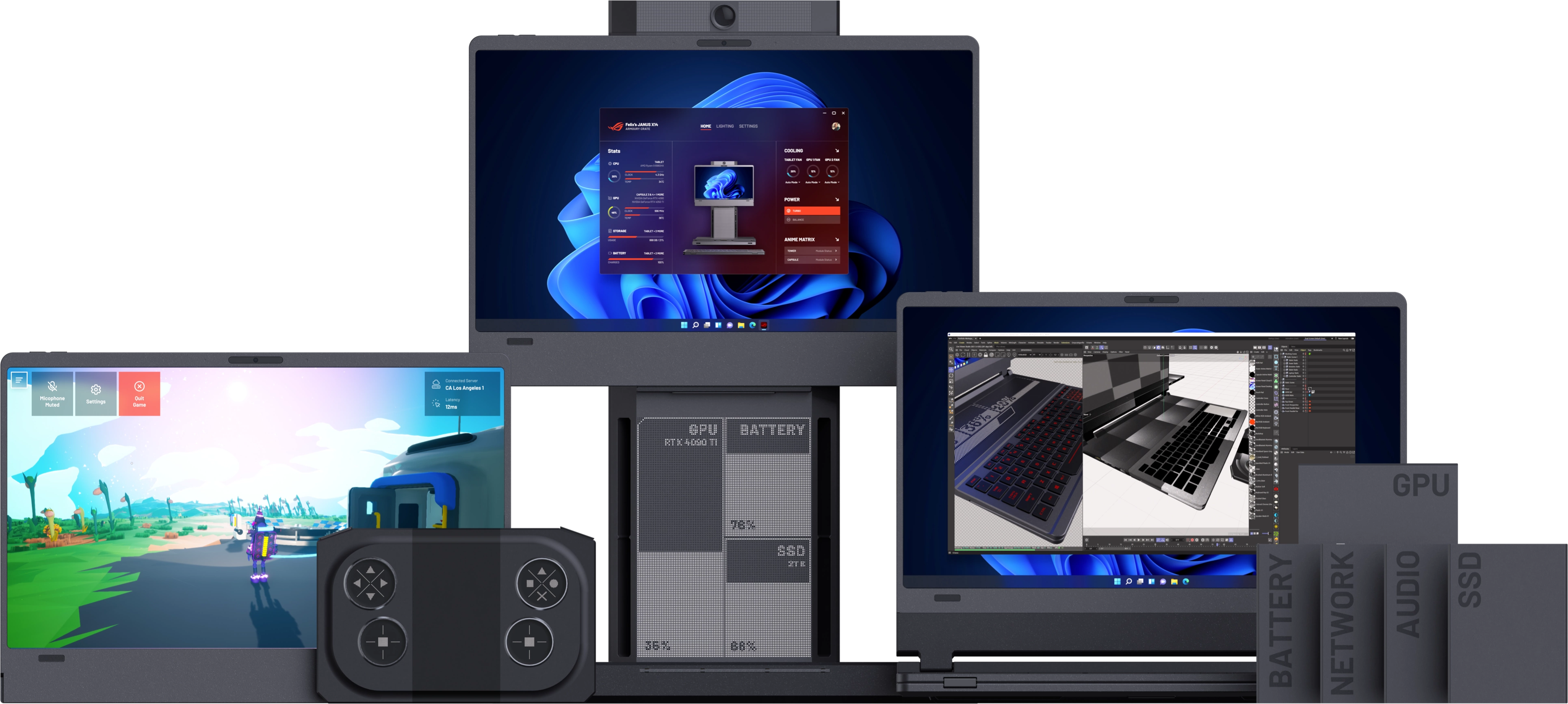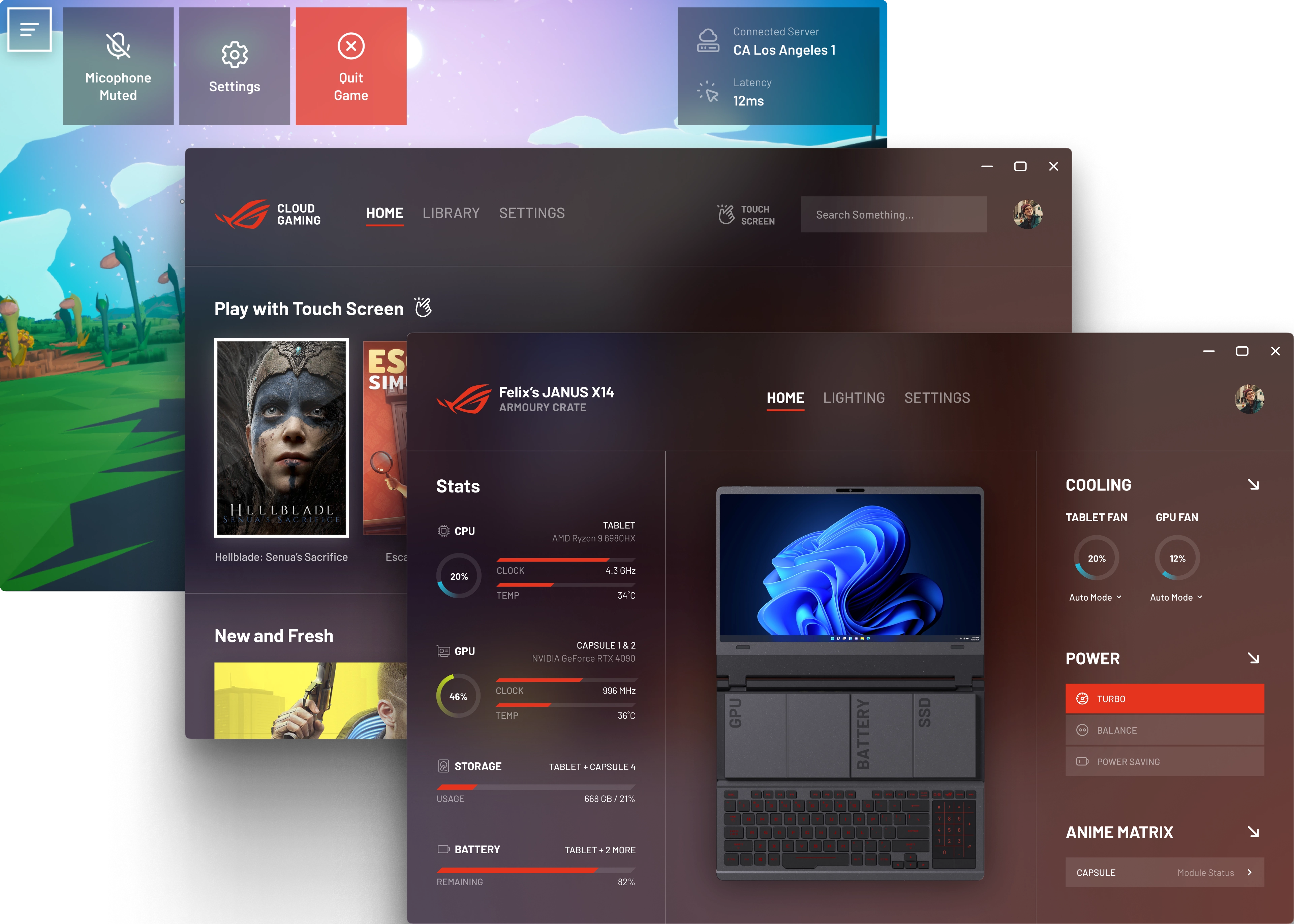A Little Summary
Team
Tianhao He
UI / UX, 3D Motion Graphic
UI / UX, Storytelling
Product Design, Protoryping
Product Design, Prototyping
Skills
Wireframes
UI Design
3D Motion Design
Brainstorming
Market Research
Product Design
Timeline
Sep – Dec '21
12 Weeks
Tools
Figma
Cinema 4D
Octane Render
After Effects
Rhino
Solidworks
KeyShot
Brief
Project Janus is the future of the all-purpose, transformable desktop/mobile PC ecosystem in 2025. It enables endless flexibility and customizable experiences for different gamers and budget ranges, allowing users to transform their devices between cloud gaming consoles, mobile workstations, or desktop powerhouses with a single centralized system while maintaining future upgradeability.
Project Janus is sponsored by, and created with the help of ASUS ROG. Big shout out to the design team who gave us invaluable help and recommendations during the process.
Challenges
Our team’s goal is to envision the future of gaming in 2025 and how ROG can offer innovative laptop products for it. To do this, we started by challenged the stereotypes of gamers and explored the real needs and desires of ROG’s potential users.

But one vital question lies right in front of us:
We wanted to know who are the potential users of ROG and what kind of setup they would prefer. We often think of gamers having a full RGB setup with multiple devices, but is that really the case for most of them?
WHO ARE THE
"TYPICAL"
GAMERS?
Finding "Typical" Gamers
To answer this question, we set out to gather what kind of gaming setup most "typical" gamers have, what devices they use, and what are their needs during their everyday gaming experience. The findings were quite surprising.

Who Are They?
We initially imagine the gamers will have flashy setup: RGB lights, spec-ed out PC with assorted peripherals, and hardware from multiple monitors and gaming consoles. But in reality, people who play games around us all have diverse preferences and needs for gaming and everyday equipment. They also balance their gaming hobby or setup with their work and school responsibilities.
30%
30% of gamers think added portability would improve their gaming experience.
52%
Gamers consider playing game to fill time while taking a break, waiting or commuting.
4 Core CPU / GTX 1060 GPU
16GB RAM / Win 10
For most gamers, the pursuit of extreme performance is not the goal, they need a scalable solution.
What Do They Need?
We also discovered something interesting through quantitative background research: people do value portability of their devices 30% of them expect more portability because 52% of them want to game within the break, waiting or commenting. We up is not even that expensive setup as we imagine for gamers.
Source: Theesa, Steam, Mintel

Who Are They?
We initially imagine the gamers will have flashy setup: RGB lights, spec-ed out PC with assorted peripherals, and hardware from multiple monitors and gaming consoles. But in reality, people who play games around us all have diverse preferences and needs for gaming and everyday equipment. They also balance their gaming hobby or setup with their work and school responsibilities.
30%
30% of gamers think added portability would improve their gaming experience.
52%
Gamers consider playing game to fill time while taking a break, waiting or commuting.
4 Core CPU / GTX 1060 GPU
16GB RAM / Win 10
For most gamers, the pursuit of extreme performance is not the goal, they need a scalable solution.
What Do They Need?
We also discovered something interesting through quantitative background research: people do value portability of their devices 30% of them expect more portability because 52% of them want to game within the break, waiting or commenting. We up is not even that expensive setup as we imagine for gamers.
Source: Theesa, Steam, Mintel
The Problems
With these research in mind, we summarized what the current problems for both the existing general gamers as well as the future potential ROG customers:
Problem 01
Gamers Desire Not To Stop. But Devices Do.
Based on the background research we made, we see a clear and robust mobile gaming need beyond just Candy Crush. Unfortunately, due to the current technology limits and developing trends (go check out the newly released CPUs and GPUs and see how much energy they need), the devices are becoming the main hindering factor for on-the-go PC gaming: low battery life, poor performance.
Problem 02
The Limited Hardware Choices
As ROG already provided a wide range of gaming laptops, the limited customization in the laptop form factor and overall premium brand identity still prevents its products from reaching larger audiences with all the different use cases. This part of the audience may prefer more budget-friendly, future-proof, or more powerful products, like upgradable desktop PCs.
Our Mission
What if we can provide a future-proof and customizable solution to overcome the limitations of the on-the-go gaming experience and cover different PC use cases?
PROJECT JANUS
ECOSYSTEM
The Project Janus Ecosystem unlocks previously unimaginable flexibility in any PC system. Configure the system with modules only fit your needs. Transform between hand-held gaming console, lightweight laptop, balanced mobile workstation, and full-fledged monster desktop PC with ease.
It's the only computer you'll ever need.
Core of the Ecosystem
Packed inside an extremely thin form factor, the core that powers the whole Project Janus Ecosystem is the X14 tablet. Utilizing the newer CPU and integrated GPU, X14 can simultaneously provide power with a punch while on the go and excellent battery life.

Cloud Gaming
3A Gaming, Anywhere
With the slim, easy-to-carry profile and expanded high-speed, low-latency 5G network coverage, the X14 tablet is the ideal choice for on-the-go cloud gaming experiences. Paired with the new ROG Cloud Gaming App and beautiful 14-inch OLED touch screen, you can immerse yourself in any AAA gaming world anywhere.
Controller
Janus Controller, A Match Made in Heaven
Further enhance your on-the-go gaming experience with the Janus Controller, explicitly designed for the X14 tablet, which can be easily mounted on the side of the tablet. The Janus Controller also comes with analog triggers, customizable haptic buttons and sticks, allowing for precise input and comfortable ergonomics. Paired with ROG Cloud Gaming App and enhanced ROG Armoury Crate, every game is within reach.
Make It a Laptop
Want to type more comfortably? Need more power? Insert the X14 Tablet into the Capsule and transform it into a laptop. Accommodate extra modules, including powerful dedicated GPU, fast and spacious SSDs, extra batteries and more, for your need, or go lightweight with just the keyboard. It's all your choice.
Modules
Expandability, Like a Desktop
Modularity and expandability are the vital goals we tried to achieve on Project Janus. We considered different use cases that the general public may encounter and designed a wide range of swappable modules. The two-slot dedicated GPU module can be configured to the users' needs and budget range, the SSD drive module for expanded storage space, the sound card module for balanced, lossless audio output, the Ethernet module that provides high-speed RJ45 connections to the laptop, and the battery module that provides extended endurance.


Capsule
Dock, Insert, Transformed
The Capsule is the portable docking station for the X14 tablet and all the modules you bring with you on the go. It features four module slots for expandability, a customizable ROG Anime Matrix™ display that can display module status in real time, and a slim, low-profile mechanical keyboard for optimal typing experience on the go.

Compact Mode
Go Lighter, Go Compact
Want to go even lighter? Directly connect the X14 tablet with the keyboard and use this compact mode. The mechanical keyboard also include a flip-out wrist rest that can provide you with the most natural typing posture.
Is That a Desktop?
Unleash the full potential of the Project Janus Ecosystem with the Tower. Utilize the dedicated GPU module at its full power without throttling, recharge your battery modules, and connect external peripherals and displays. This is the right way to use a "laptop" in a stationary setup.
The Tower
The Ultimate True Desktop Experience
The Tower is the extended desktop version of the Capsule. It also features four module slots that are covered with maximum power and cooling. The X14 tablet can easily be seated on the height-adjustable mount for the best viewing angle. A high-quality webcam and ROG Anime Matrix™ display can also be suitable for different use cases, from streaming to video conferencing.


Power
Power to All
Without the limitation of physical form factor and energy constraints, the Tower allows the dedicated GPU module to run at its limit without thermal throttling. This allows the setup to be easily suitable for the heaviest workload you can possibly throw at it, from high frame rate gaming to massive 3D scene renderings.

Connectivity
Connect Everything All At Once
The Tower also provides extensive connectivity, allowing you to connect third-party peripherals, high-resolution external displays, and Janus low-profile keyboard / trackpad easily. You can create your own unique setup around the Tower with limitless possibilities. The Capsule can also be easily connected to the Tower, allowing extra module expandability.
New Software Experiences
Introducing the brand new ROG Cloud Gaming Services, optimized for X14's 5G connectivity. Play with a mouse and keyboard, controller, or touch screen to your liking. Control your Project Janus Ecosystem with reimagined ROG Armoury Crate. View your module status and power profile at a glance, and switch the modules up without any distractions from your task.
ROG Cloud Gaming Services
All Your Game in One Place
ROG Cloud Gaming Services is the one place for you to access all your games in the library. Discover new daily recommendations easily and play the one that is best optimized for your current setup with one click.


Adapt to Your Setup
Connect your Janus Controller, and the ROG Cloud Gaming Services will automatically switch the profile and adapt to the controller, you can even view the games that are optimized for Janus Controller first — No additional setup. Just play.

Intuitive In-game Control & Status
Check the cloud gaming status, connectivity, and latency at a glance with the in-game overlay. Easily adjust the button-mapping and microphone control without switching into a different window.
New Armoury Crate
Manage All Within the Ecosystem
The reimagined Armoury Crate is the new hub for you to manage everything within the Project Janus Ecosystem. View your current setup, all of your modules and their setup, the active power profile, and AniMe Matrix's lighting effect all in one place.


Swap Module Instantly
See the currently installed module and their position in the Capsule or Tower intuitively, and eject or swap them without the hassle of figuring out how.

Change Setup Without Interruptions
Armoury Crate automatically halts all applications and system processes when switching setup or swapping modules, so you don't have to worry about restarting the whole system or losing the flow of working and playing.
Behind the Scene Process
01
Market & Opportunities
We also looked into the current market to see the competitive landscape. Because of the various needs in both daily PC use and gaming, there are already diverse devices and setups that covers all the quadrant we set up: leaning towards gaming or productivity and leaning towards mobile or stationary setup. But there's no single product that can adapt to all these different use cases. This is where we started ideating about Project Janus' ecosystem and where it can differentiate from its competitors.

02
Ideation & Trend Research
At the beginning of the project, we conducted extensive ideation and trend research, including a thorough analysis of existing products on the market and existing ROG products, as well as identifying current and emerging trends in technology and user behavior. The purpose of this research was to gain a deep understanding of the strengths and weaknesses of current products and to identify areas of opportunity for Project Janus to improve upon and innovate. By conducting this research, the team was able to establish a clear vision for a transformable PC setup.

03
Ad-hoc Persona
In order to help us form the product use cases, we created an ad-hoc persona named Felix, who embodies the best representatives of our target users. Felix is a designer as well as a gamer who values a good gaming experience while also appreciating multi-purpose products. Our research and persona development phase allowed us to identify and understand our target users' needs and preferences, which informed the whole ecosystem's design to meet those needs and provide a thorough user journey.

04
User Journey
The user journey we created for Project Janus plays a crucial role in contributing to the overall success of the project. By understanding our target users' journey and how they use our product, we were able to optimize both the hardware and software design to provide a more seamless and efficient user experience across all use cases. This user journey also led to the physical prototype play test we did in the following of the project.

05
Form Factor & Modeling Ideation
We also went through multiple rounds of form factor ideations in the process. These sketches and preliminary models helped us further defined the modular concept we have in the final design, while also allowed as to do rapid iterations on the form, aesthetic, and overall setup on the user's desk.

06
Physical Prototype & Play Testing
We made the physical prototype of all the components in the ecosystem with 3D printing and cardboard in order to test the scale in real life and how different components can work together. Combined with the user scenario we created, we are able to simulate how the persona can interact with different modules and how complex or inconvenient some procedure may be. Some of the findings facilitate the design changes on both hardware and software side, and are made into the final proposal.
07
UI Design & Branding
The name "Janus" is originated from the Greek god of change, as it fits our project's main idea. As for the branding and UI design, besides multiple rounds of low and mid-fi wireframes, we referenced the existing ROG branding, which leans towards the hardcore gaming community, and made it more modern. We chose Barlow as the primary font and utilized transparency that fits the Windows 11's Mica and Acrylic materials to make the UI both ROG unique and close to the native experience.

What I Learned
Collaborating with designers with hardware product design background and working together in a hackathon-like sponsored studio is an unforgettable experience for me, and here are some points I learned when developing this project:
Lesson 01
The Importance of Hands-on Experiences
One of the most critical steps during the whole project was how we utilized physical prototypes built via 3D printing and cardboard to validate our concepts. This hands-on approach with the tangible prototype was crucial in refining our design details, resulting in several revisions, and this experience reinforced the importance of incorporating a hands-on approach to design and testing, which I plan to continue utilizing in future projects, no matter physical or digital, to ensure successful outcomes.
Lesson 02
Storytelling & Persuasiveness
During the design process, I gained valuable insights into the power of storytelling (kudos to Rose for our amazing final presentation!). In many real-world scenarios, designers must present their work to stakeholders who prioritize persuasive and practical products over pixel-perfect design details. By balancing both the practical and aesthetic aspects of design, designers can create more persuasive and impactful presentations that resonate with stakeholders and drive successful outcomes.
Shout Out To...
My amazing teammates, Rose, Chencheng, and Zexi, for the fantastic experience and collaboration during the class; Our TA, Drake, for the feedback and help; Our instructors, Elise and Jeff, for the continued support and instructions; and of course ASUS ROG for giving us the opportunity to get hands-on experiences with their products and brainstorming the future of gaming.




